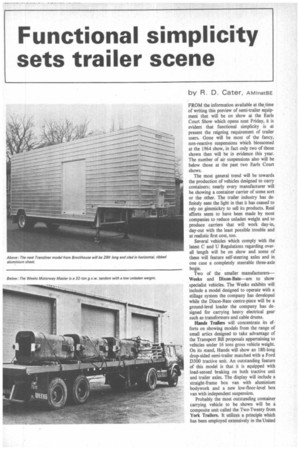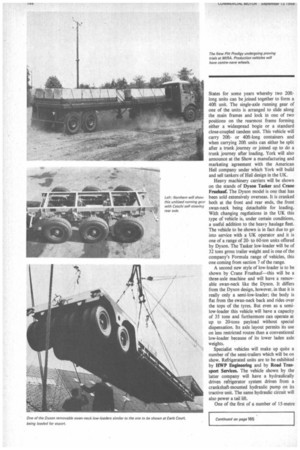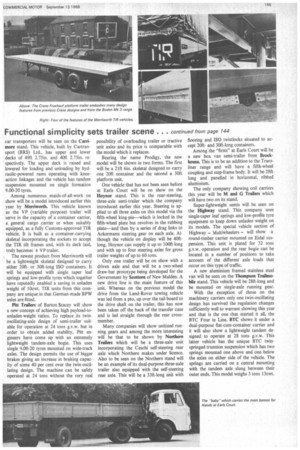Functional simplicity sets trailer scene
Page 145

Page 146

Page 167

If you've noticed an error in this article please click here to report it so we can fix it.
by R. D. Cater, AMInstRE
FROM the information available at the time of writing this preview of semi-trailer equipment that will be on show at the Earls Court Show which opens next Friday, it is evident that functional simplicity is at present the reigning requirement of trailer users. Gone will be most of the fancy, non-reactive suspensions which blossomed at the 1964 show, in fact only two of those shown then will be in evidence this year. The number of air suspensions also will be below those at the past two Earls Court shows.
The most general trend will be towards the production of vehicles designed to carry containers; nearly every manufacturer will be showing a container carrier of some sort or the other. The trailer industry has definitely seen the light in that it has ceased to rely on gimmickry to sell its products. Real efforts seem to have been made by most companies to reduce unladen weight and to produce carriers that will work day-in, day-out with the least possible trouble and at realistic first cost, too.
Several vehicles which comply with the latest C and U Regulations regarding overall length will be on show and some of these will feature self-steering axles and in one case a completely steerable three-axle bogie.
Two of the smaller manufacturers— Weeks and Dixon-Bate--are to show specialist vehicles. The Weeks exhibits will include a model designed to operate with a stillage system the company has developed while the Dixon-Bate centre-piece will be a ground-level loader the company has designed for carrying heavy electrical gear such as transformers and cable drums.
Hands Trailers will concentrate its efforts on showing models from the range of small artics designed to take advantage of the Transport Bill proposals appertaining to vehicles under 16 tons gross vehicle weight. On its stand, Hands will show an 18ft-long drop-sided semi-trailer matched with a Ford D300 tractive unit. An outstanding feature of this model is that it is equipped with load-sensed braking on both tractive unit and trailer axles. The display will include a straight-frame box van with aluminium bodywork and a new low-floor-level box van with independent suspension.
Probably the most outstanding container carrying vehicle to be shown will be a composite unit called the Two-Twenty from York Trailers. It utilizes a principle which has been employed extensively in the United
States for some years whereby two 20ftlong units can be joined together to form a 40ft unit. The single-axle running gear of one of the units is arranged to slide along the main frames and lock in one of two positions on the rearmost frame forming either a widespread bogie or a standard close-coupled tandem unit. This vehicle will carry 20ftor 40ft-long containers and when carrying 2011 units can either be split after a trunk journey or joined up to do a trunk journey after loading. York will also announce at the Show a manufacturing and marketing agreement with the American Heil company under which York will build and sell tankers of Heil design in the UK.
Heavy machinery carriers will be shown on the stands of Dyson Tasker and Crane Fruehauf. The Dyson model is one that has been sold extensively overseas. It is cranked both at the front and rear ends, the front swan-neck being detachable for loading. With changing regulations in the UK this type of vehicle is, under certain conditions, a useful addition to the heavy haulage fleet. The vehicle to be shown is in fact due to go into service with a UK operator and it is one of a range of 20to 60-ton units offered by Dyson. The Tasker low-loader will be of 32 tons gross trailer weight and is one of the company's Formula range of vehicles, this one coming from section 7 of the range.
A second new style of low-loader is to be shown by Crane Fruehauf—this will be a three-axle machine and will have a removable swan-neck like the Dyson. It differs from the Dyson design, however, in that it is really only a semi-low-loader; the body is flat from the swan-neck back and rides over the tops of the tyres. But even as a semilow-loader this vehicle will have a capacity of 35 tons and furthermore can operate at up to 20-tons payload without special dispensation. Its axle layout permits its use on less restricted routes than a conventional low-loader because of its lower laden axle weights.
Specialist vehicles will make up quite a number of the semi-trailers which will be on show. Refrigerated units are to be exhibited by HWP Engineering and by Road Transport Services. The vehicle shown by the latter company will have a hydraulically driven refrigerator system driven from a crankshaft-mounted hydraulic pump on its tractive unit. The same hydraulic circuit will also power a tail lift.
One of the first of a number of 15-metre
car transporters will be seen on the Carrimore stand. This vehicle, built by Cartransport (BRS) Ltd., has upper and lower decks of 49ft 2.75in. and 40ft 2.75in. respectively. The upper deck is raised and lowered for loading and unloading by hydraulic-powered rams operating with kneeaction linkages and the vehicle has tandem suspension mounted on single formation 9.00-20 tyres.
Among numerous maids-of-all-work on show will be a model introduced earlier this year by Merriworth. This vehicle known as the VP (variable purpose) trailer will serve in the capacity of a container carrier, a general cargo carrier or when suitably equipped, as a fully Customs-approved TIR vehicle. It is built as a container-carrying skeletal incorporating the sockets to accept the TIR tilt frames and, with its deck laid, truly becomes a VP trailer.
The newest product from Merriworth will be a lightweight skeletal designed to carry either 20ftor 30ft-long ISO containers. It will be equipped with single taper leaf springs and low-profile tyres which together have reputedly enabled a saving in unladen weight of lOcwt. TIR units from this company are unique in that German-made BPW axles are fitted.
Pitt Trailers of Barton Stacey will show a new concept of achieving high payload-tounladen-weight ratios. To replace its twinoscillating-axle design of semi-trailer suitable for operation at 24 tons g.v.w. but in order to obtain added stability, Pitt engineers have come up with an extremely lightweight tandem-axle bogie. This uses single 9.00-20 tyres mounted on wide-track axles. The design permits the use of bigger brakes giving an increase in braking capacity of some 40 per cent over the twin-oscillating design. The machine can be safely operated at 24 tons without the very real possibility of overloading trailer or tractive unit axles and its price is comparable with the model which it replaces.
Bearing the name Prodigy, the new model will be shown in two forms. The first will be a 21ft 6in. skeletal designed to carry one 20ft container and the second a 30ft platform unit.
One vehicle that has not been seen before at Earls Court will be on show on the Hoynor stand. This is the rear-steering, three-axle semi-trailer which the company introduced earlier this year. Steering is applied to all three aides on this model via the fifth-wheel king-pin—which is locked in the fifth-wheel plate but revolves in the rubbing plate—and then by a series of drag links to Ackermann steering gear on each axle. Although the vehicle on display will be 40ftlong, Hoynor can supply it up to 100ft-long and with up to four steering axles for gross trailer weights of up to 60 tons.
Only one trailer will be on show with a driven axle and that will be a two-wheel draw-bar prototype being developed for the Government by Seottorn of New Malden. A new drive line is the main feature of this unit. Whereas on the previous model the drive from the Land-Rover towing vehicle was led from a pto, up over the tail-board to the drive shaft on the trailer, this has now been taken off the back of the transfer case and is led straight through the rear crossmember.
Many companies will show unitized running gears and among the more interesting will be that to be shown by Northern Trailers which will be a three-axle unit incorporating the Ceschi self-steering rear axle which Northern makes under licence. Also to be seen on the Northern stand will be an example of its dual-purpose three-axle trailer also equipped with the self-steering rear axle. This will be a 33ft-long unit with flooring and ISO twistlocks situated to accept 20ftand 30ft-long containers.
Among. the "firsts" at Earls Court will be a new box van semi-trailer from Brock
house. This is to be an addition to the Transliner range and will have a fifth-wheel coupling and step-frame body. It will be 28ftlong and panelled in horizontal, ribbed aluminium.
The only company showing coil carriers this year will be NI and G Trailers which will have two on its stand.
Super-lightweight semis will be seen on the Highway stand. This company uses single-taper leaf springs and low-profile tyre equipment to keep down unladen weight on its models. The special vehicle section of Highway Multiwheelers will show a round-timber carrier mounted on Eidal suspension. This unit is plated for 32 tons g.v.w. operation and the rear bogie can be located in a number of positions to take account of the different axle loads that occur on this type of traffic.
A new aluminium framed stainless steel van will be seen on the Thompson Trailmo bile stand. This vehicle will be 28ft-long and be mounted on single-axle running gear. With the exception of those on the machinery carriers only one twin-oscillating design has survived the regulation changes sufficiently well to warrant showing this year and that is the one that started it all, the BTC Four in Line. BTC shows it under a dual-purpose flat-cum-container carrier and it will also show a lightweight tandem de signed to operate at 28 tons g.v.w. This latter vehicle has the unique BTC twinspringed trunnion suspension which has two springs mounted one above and one below the axles on either side of the vehicle. The springs are carried on a central mounting with the tandem axle slung between their outer ends. This model weighs 3 tons 13cwt.




































































































































































































































































